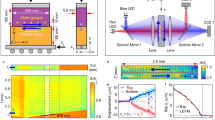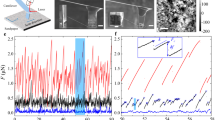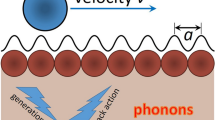Abstract
The evolution of frictional strength has great fundamental and practical importance. Applications range from earthquake dynamics1,2,3,4 to hard-drive read/write cycles5. Frictional strength is governed by the resistance to shear of the large ensemble of discrete contacts that forms the interface that separates two sliding bodies. An interface’s overall strength is determined by both the real contact area and the contacts’ shear strength6,7. Whereas the average motion of large, slowly sliding bodies is well-described by empirical friction laws3,8,9,10, interface strength is a dynamic entity that is inherently related to both fast processes such as detachment/re-attachment11,12,13,14 and the slow process of contact area rejuvenation6,7,13,15,16. Here we show how frictional strength evolves from extremely short to long timescales, by continuous measurements of the concurrent local evolution of the real contact area and the corresponding interface motion (slip) from the first microseconds when contact detachment occurs to large (100-second) timescales. We identify four distinct and inter-related phases of evolution. First, all of the local contact area reduction occurs within a few microseconds, on the passage of a crack-like front. This is followed by the onset of rapid slip over a characteristic time, the value of which suggests a fracture-induced reduction of contact strength before any slip occurs. This rapid slip phase culminates with a sharp transition to slip at velocities an order of magnitude slower. At slip arrest, ‘ageing’ immediately commences as contact area increases on a characteristic timescale determined by the system’s local memory of its effective contact time before slip arrest. We show how the singular logarithmic behaviour generally associated with ageing is cut off at short times16. These results provide a comprehensive picture of how frictional strength evolves from the short times and rapid slip velocities at the onset of motion to ageing at the long times following slip arrest.
This is a preview of subscription content, access via your institution
Access options
Subscribe to this journal
Receive 51 print issues and online access
$199.00 per year
only $3.90 per issue
Buy this article
- Purchase on Springer Link
- Instant access to full article PDF
Prices may be subject to local taxes which are calculated during checkout



Similar content being viewed by others
References
Scholz, C. H. Earthquakes and friction laws. Nature 391, 37–42 (1998)
Dieterich, J. H. Earthquake nucleation on faults with rate-dependent and state-dependent strength. Tectonophysics 211, 115–134 (1992)
Marone, C. Laboratory-derived friction laws and their application to seismic faulting. Annu. Rev. Earth Planet. Sci. 26, 643–696 (1998)
Ben-Zion, Y. Collective behavior of earthquakes and faults: continuum-discrete transitions, progressive evolutionary changes, and different dynamic regimes. Rev. Geophys. 46, 1–70 (2008)
Urbakh, M., Klafter, J., Gourdon, D. & Israelachvili, J. The nonlinear nature of friction. Nature 430, 525–528 (2004)
Dieterich, J. H. & Kilgore, B. D. Direct observation of frictional contacts—new insights for state-dependent properties. Pure Appl. Geophys. 143, 283–302 (1994)
Bowden, F. P. & Tabor, D. The Friction and Lubrication of Solids Ch. 1 (Oxford Univ. Press, 2001)
Dieterich, J. H. Modeling of rock friction. 1. Experimental results and constitutive equations. J. Geophys. Res. 84, 2161–2168 (1979)
Rice, J. R. & Ruina, A. L. Stability of steady frictional slipping. J. Appl. Mech. 50, 343–349 (1983)
Baumberger, T., Berthoud, P. & Caroli, C. Physical analysis of the state- and rate-dependent friction law. II. Dynamic friction. Phys. Rev. B 60, 3928–3939 (1999)
Ben-Zion, Y. Dynamic ruptures in recent models of earthquake faults. J. Mech. Phys. Solids 49, 2209–2244 (2001)
Rubinstein, S. M., Cohen, G. & Fineberg, J. Detachment fronts and the onset of dynamic friction. Nature 430, 1005–1009 (2004)
Rubinstein, S., Cohen, G. & Fineberg, J. Contact area measurements reveal loading-history dependence of static friction. Phys. Rev. Lett. 96, 256103 (2006)
Xia, K., Rosakis, A. J. & Kanamori, H. Laboratory earthquakes: the sub-Raleigh-to-supershear rupture transition. Science 303, 1859–1861 (2004)
Rottler, J. & Robbins, M. O. Unified description of aging and rate effects in yield of glassy solids. Phys. Rev. Lett. 95, 225504 (2005)
Nakatani, M. & Scholz, C. H. Intrinsic and apparent short-time limits for fault healing: theory, observations, and implications for velocity-dependent frictionl. J. Geophys. Res. Solid Earth 111, B12208 (2006)
Kim, H. J., Kim, W. K., Falk, M. L. & Rigney, D. A. MD simulations of microstructure evolution during high-velocity sliding between crystalline materials. Tribol. Lett. 28, 299–306 (2007)
Ohnaka, M. & Kuwahara, Y. Characteristic features of local breakdown near a crack-tip in the transition zone from nucleation to unstable rupture during stick-slip shear failure. Tectonophysics 175, 197–220 (1990)
Okubo, P. G. & Dieterich, J. H. Effects of physical fault properties on frictional instabilities produced on simulated faults. J. Geophys. Res. 89, 5817–5827 (1984)
Rubinstein, S. M., Cohen, G. & Fineberg, J. Dynamics of precursors to frictional sliding. Phys. Rev. Lett. 98, 226103 (2007)
Berthoud, P. & Baumberger, T. G'Sell, C. & Hiver, J. M. Physical analysis of the state- and rate-dependent friction law: static friction. Phys. Rev. B 59, 14313–14327 (1999)
Marone, C. The effect of loading rate on static friction and the rate of fault healing during the earthquake cycle. Nature 391, 69–72 (1998)
Dieterich, J. H. Time-dependent friction in rocks. J. Geophys. Res. 77, 3690–3697 (1972)
Fuller, K. N. G., Fox, P. G. & Field, J. E. Temperature rise at tip of fast-moving cracks in glassy polymers. Proc. R. Soc. Lond. A 341, 537 (1975)
Rice, J. R. Heating and weakening of faults during earthquake slip. J. Geophys. Res. Solid Earth 111, B05311 (2006)
Nielsen, S., Di Toro, G., Hirose, T. & Shimamoto, T. Frictional melt and seismic slip. J. Geophys. Res. Solid Earth 113, B01308 (2008)
Beeler, N. M., Tullis, T. E. & Goldsby, D. L. Constitutive relationships and physical basis of fault strength due to flash heating. J. Geophys. Res. Solid Earth 113, B01401 (2008)
Acknowledgements
We acknowledge comments by J. R. Rice, M. O. Robbins, T. Baumberger and C. Caroli. This work, as part of the ESF EUROCORES programme FANAS, was supported by the Israel Science Foundation (grant 57/07). We also acknowledge support of the US–Israel Binational Science Foundation (grant 2006288).
Author Contributions All authors contributed to the design of the experiment. O.B.-D. performed the measurements. All authors contributed to the analysis and writing of the manuscript.
Author information
Authors and Affiliations
Corresponding author
Ethics declarations
Competing interests
The authors declare no competing financial interests.
Supplementary information
Supplementary Information
This file contains Supplementary Methods, Supplementary Figure S1 with Legend, Supplementary Data and Supplementary References. (PDF 395 kb)
Rights and permissions
About this article
Cite this article
Ben-David, O., Rubinstein, S. & Fineberg, J. Slip-stick and the evolution of frictional strength. Nature 463, 76–79 (2010). https://doi.org/10.1038/nature08676
Received:
Accepted:
Issue Date:
DOI: https://doi.org/10.1038/nature08676
This article is cited by
-
Predicting frictional aging from bulk relaxation measurements
Nature Communications (2023)
-
Logarithmic aging via instability cascades in disordered systems
Nature Physics (2023)
-
Mineral evolution facilitated Earth’s oxidation
Communications Earth & Environment (2023)
-
How frictional slip evolves
Nature Communications (2023)
-
Intermittent lab earthquakes in dynamically weakening fault gouge
Nature (2022)
Comments
By submitting a comment you agree to abide by our Terms and Community Guidelines. If you find something abusive or that does not comply with our terms or guidelines please flag it as inappropriate.



